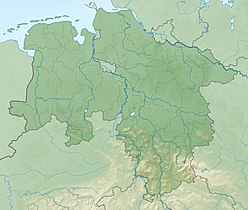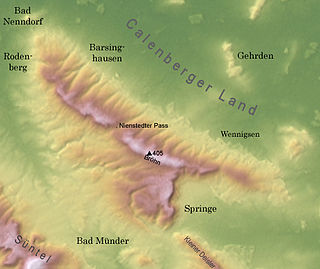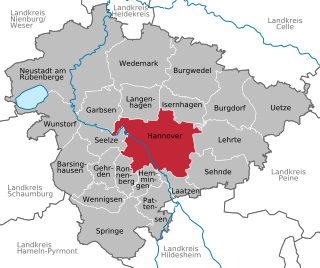
The Principality of Calenberg was a dynastic division of the Welf duchy of Brunswick-Lüneburg established in 1432. Calenberg was ruled by the House of Hanover from 1635 onwards; the princes received the ninth electoral dignity of the Holy Roman Empire in 1692. Their territory became the nucleus of the Electorate of Hanover, ruled in personal union with the Kingdom of Great Britain from 1714 onwards. The principality received its name from Calenberg Castle, a residence of the Brunswick dukes.

Barsinghausen is a town in the district of Hanover, in Lower Saxony, Germany. It is situated at the Deister chain of hills approx. 20 km west of Hanover. Barsinghausen belongs to the historic landscape Calenberg Land and was first mentioned in 1193.

Springe is a town in the district of Hanover, in Lower Saxony, Germany. It is situated near the Deister hills, 22 kilometres (14 mi) southwest of Hanover.
The Hildesheim Börde is a natural region, 272 km2 in area, in the northern part of Hildesheim district, which is known for its especially rich black earth loess soil.
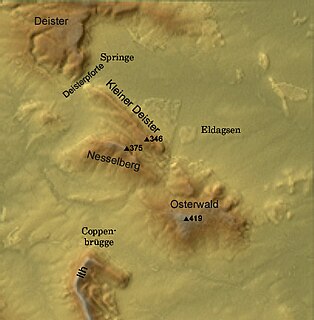
The Nesselberg is a ridge up to 378.2 m above sea level (NN) high in the Calenberg Highland which, together with the Kleiner Deister and the Osterwald, forms a group of three contiguous hill regions in the northwestern part of the Leine Uplands. It lies between Altenhagen I and Coppenbrügge in Lower Saxony, Germany.

The Kleiner Deister is a ridge of hills in the Calenberg Uplands which, together with the Nesselberg and the Osterwald, forms a group of three adjacent hill ranges in the northern part of the Leine Uplands. It lies between Springe and Eldagsen in Hanover region in Lower Saxony, Germany.
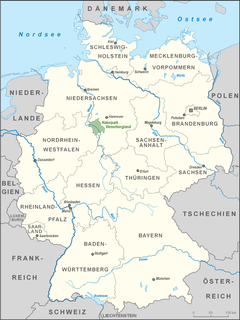
The Weser Uplands-Schaumburg-Hamelin Nature Park lies on the northern edge of the German Central Uplands where it transitions to the North German Plain, about 50 kilometres (31 mi) southwest of Hanover. The sponsor of the nature park, which was founded in 1975, is the state of Lower Saxony. The park extends along the Weser valley between Rinteln and Hamelin and includes parts of the Schaumburg Land, Calenberg, Lippe and Pyrmont Uplands from Bad Nenndorf in the north to Bad Pyrmont in the south, Bückeburg and Bad Eilsen in the west and Bad Münder and Osterwald in the east. Its highest elevation is in the Süntel hills.

Calenberg Castle was a medieval lowland castle in central Germany, near Schulenburg in the borough of Pattensen, 13 km west of the city of Hildesheim. It was built as a water castle in 1292 by the Welf duke, Otto the Strict, in der Leine river meadows between 2 branches of the Leine river on the southern part of the chalk marl hill of the Calenberg. At the start of the 16th century it was converted into a fort (Feste). In the 15th century, Fort Calenberg gave its name to the Welf Principality of Calenberg. Following the Thirty Years' War it lost its military importance and was slighted. Today it is a ruin with underground vaults that are surrounded by high ramparts.
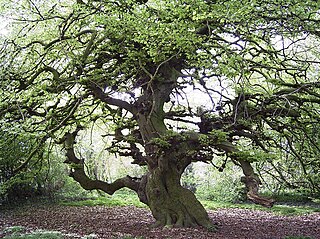
The Deister-Süntel valley lies in the northeast Weser Uplands in the north German state of Lower Saxony between the ridges of the Bückeberg, Süntel and Deister in the districts of Schaumburg and Hameln-Pyrmont.
The Hanover–Altenbeken railway is a two-track electrified main line in the German states of Lower Saxony and North Rhine-Westphalia. It is now a part of the Hanover S-Bahn network.
The Deister Railway is a railway line in the German state of Lower Saxony between Weetzen and Haste. It is now a section of the Hanover S-Bahn network.

The Osterwald is a ridge in the Calenberg Uplands and together with the Nesselberg and the Kleiner Deister forms a unified group of three adjacent ranges in the Leine Uplands. It lies between Coppenbrügge, Eldagsen and Elze in the North German state of Lower Saxony.

The Bröhn, is the highest hill in the Deister range in the German state of Lower Saxony. It owes its name to the broom growing here. The highest point of the hill is close to the Anna Tower, an observation tower on the territory of the town of Springe close to the boundary of the municipality of Wennigsen.

The Benther Berg is a ridge, up to 173.3 m above sea level (NN), in the Calenberg Land near Benthe in Hanover Region in the German state of Lower Saxony.

A börde is a region of highly fertile lowland in North Germany, a "fertile plain". These landscapes often cover great areas and are particularly important for arable farming on account of their rich soils.

The Deister Gate is a 550-metre-wide gap between the Deister and Kleiner Deister hill ridges in Springe in Hanover Region, Lower Saxony, Germany. The height of the pass varies between 130 m above NN to 120 m above NN. The River Haller rises in the Deister Gate. Several transport and supply routes run through the Deister Gate.




